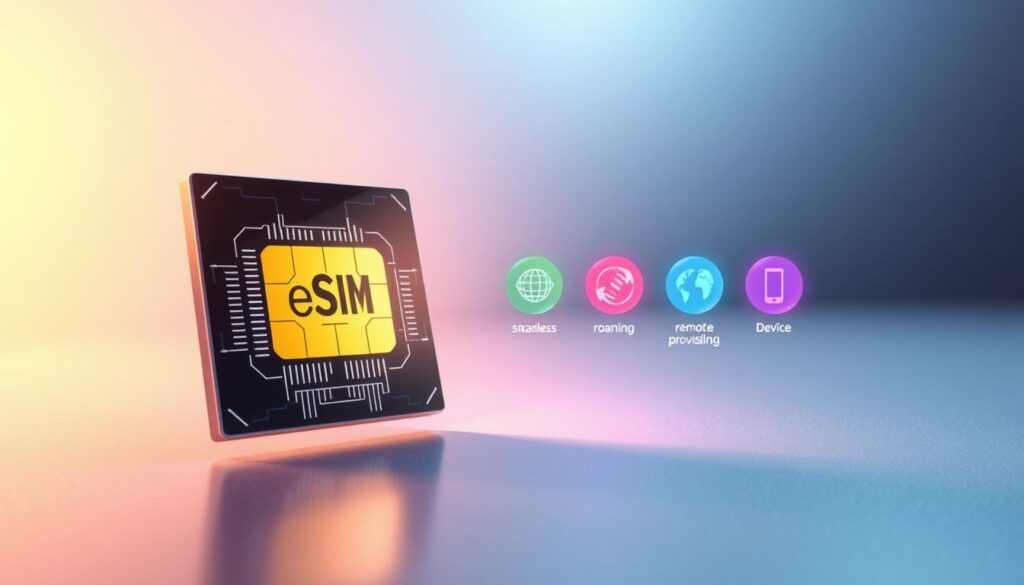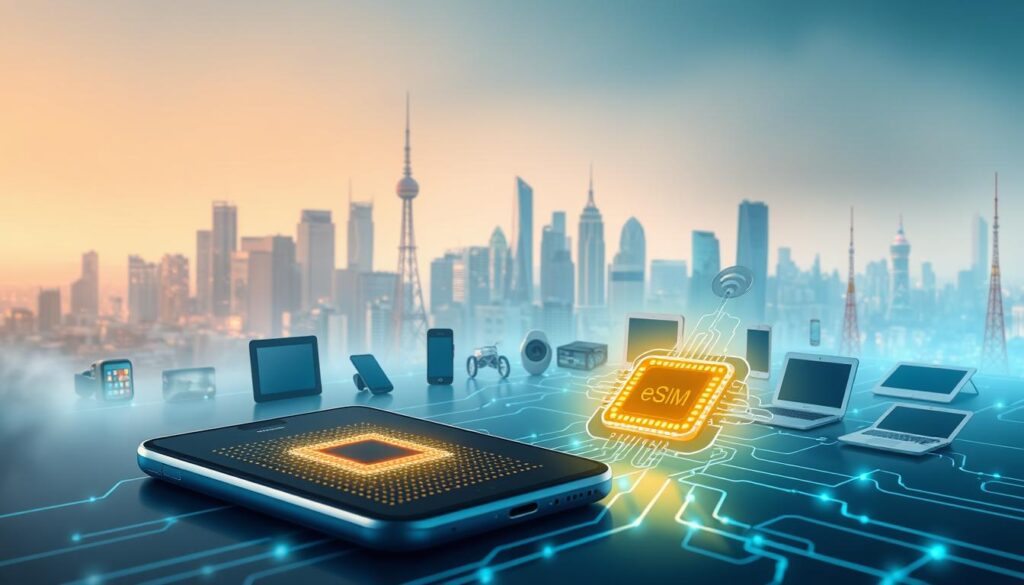Understanding eSIM Technology: Benefits and Applications
Have you ever felt frustrated by the hassle of swapping SIM cards when traveling or switching carriers? We’ve all been there. Traditional SIM cards, while reliable, can be cumbersome. Enter eSIM technology, a game-changer in modern connectivity. Unlike physical SIMs, eSIMs are embedded directly into your device, eliminating the need for a removable card.
This innovation isn’t just about convenience. It’s about transforming how we stay connected. With eSIMs, you can store multiple profiles on a single device, making it easier to switch carriers or manage different plans. For instance, the iPhone 15 has embraced this technology exclusively, showcasing its growing adoption1.
Beyond personal use, eSIMs are revolutionizing industries like healthcare and logistics. They enable remote monitoring and real-time data transmission, improving efficiency and reducing costs2. Whether you’re a frequent traveler, a digital nomad, or a business professional, eSIMs offer a seamless and future-proof solution.
Key Takeaways
- eSIMs are embedded in devices, eliminating the need for physical SIM cards.
- They simplify carrier switching and support multiple network profiles.
- eSIMs improve device performance by saving space and reducing logistics costs.
- They are widely adopted in industries like healthcare, logistics, and manufacturing.
- Devices like the iPhone 15 use eSIM technology exclusively.
What is eSIM Technology? Breaking Down the Basics
Gone are the days of fumbling with tiny SIM cards; eSIMs are here to simplify connectivity. Unlike traditional SIMs, an eSIM is embedded directly into your device, making it a permanent part of your hardware. This innovation is soldered into devices and can be activated using QR codes, offering a hassle-free way to connect to a carrier3.
At its core, an eSIM serves the same purpose as a physical SIM—it connects your device to a network. However, it goes beyond by allowing remote provisioning and the ability to store multiple profiles. This means you can switch between carriers or plans without needing a new SIM card4.
Defining eSIM and Its Core Functions
An eSIM is a small chip embedded in your device, measuring just 2.5 mm x 2.3 mm and 0.2 mm thick. It occupies 60 times less space than a nano SIM, freeing up room for other components like larger batteries3. Its primary functions include:
- Remote activation via QR codes or apps.
- Hosting multiple network profiles simultaneously.
- Simplifying carrier switching for users.
eSIM vs. Traditional SIM: Key Differences
Traditional SIM cards require physical replacement when switching carriers, but eSIMs eliminate this step entirely. For example, the iPhone 15 exclusively uses eSIMs, showcasing how this technology is becoming the standard5. Here’s a quick comparison:
| Feature | eSIM | Traditional SIM |
|---|---|---|
| Size | 2.5 mm x 2.3 mm | 15 mm x 25 mm (2FF) |
| Activation | Remote via QR code | Physical replacement |
| Profiles | Multiple | Single |
| Space Efficiency | High | Low |
eSIMs also improve security by being harder to remove or tamper with. This makes them ideal for devices like smartphones, tablets, and even wearables. With over 400 mobile operators supporting eSIMs globally, this technology is set to dominate the future of connectivity3.
Key Benefits and Advantages of eSIM Technology
Switching carriers or traveling abroad no longer requires physical SIM cards. Embedded solutions simplify this process by enabling over-the-air profile updates. This eliminates the need for physical swaps, saving users valuable time and effort6.

One of the standout benefits is the ability to store multiple profiles on a single device. For example, iPhones allow two active profiles simultaneously, making it easier to manage personal and work numbers6. This flexibility is especially useful for frequent travelers who require seamless international connectivity.
Simplifying Carrier Switching and Activation
Embedded solutions make carrier switching effortless. With just a QR code or a carrier app, users can activate a new profile in minutes. This process is not only faster but also more secure, reducing the risk of SIM swap attacks6.
For enterprises, this innovation reduces logistical challenges. Companies no longer need to ship physical cards, cutting costs and streamlining operations. This is particularly beneficial for IoT devices, where remote activation is essential7.
Space-Saving Design and Enhanced Device Performance
By removing the SIM tray, manufacturers can design smaller devices with larger batteries. This size advantage also improves water resistance, enhancing device durability6.
Embedded solutions also support faster software updates. Users can switch networks or plans without waiting for hardware modifications. This flexibility is crucial in the rapidly growing IoT ecosystem, where seamless connectivity is key7.
As Digital Trends highlights, “Embedded solutions are not just a convenience—they’re a necessity for modern connectivity.” This innovation is shaping the future of how we stay connected, offering a smarter and more efficient way to manage networks.
eSIM Technology in the Device Ecosystem
The way we connect is evolving, and embedded solutions are leading the charge. From smartphones to wearables, this innovation is reshaping the device ecosystem. It’s not just about staying connected—it’s about doing it smarter and more efficiently.

Integration in Smartphones and Tablets
Major brands like Apple, Google, and Samsung have embraced embedded solutions in their latest devices. For instance, the iPhone 15 exclusively uses this feature, eliminating the need for a physical SIM tray8. This shift allows for sleeker designs and improved durability, enhancing the form factor of modern phones.
Tablets are also benefiting from this integration. Devices like the iPad Pro now support multiple profiles, making it easier for users to switch between personal and work accounts8. This flexibility is a game-changer for consumers who rely on these devices for both productivity and entertainment.
Adoption in Wearables and IoT Devices
Wearables like smartwatches are becoming more independent, thanks to embedded solutions. For example, the Apple Watch Series 8 can operate without being tethered to a phone, offering greater freedom to users8. This autonomy is particularly useful for fitness enthusiasts and professionals on the go.
In the IoT space, embedded solutions are transforming how devices connect. Smart home devices, industrial sensors, and even healthcare equipment now rely on this standard for seamless connectivity9. The ability to manage thousands of IoT devices remotely is saving time and resources for businesses worldwide.
As the market grows, more operators are adopting this technology, ensuring faster and more reliable connections8. This widespread support is driving innovation across industries, making embedded solutions a cornerstone of modern connectivity.
Navigating the Carrier, Network, and Regulatory Landscape
The global shift toward embedded connectivity is reshaping how carriers and networks operate. As more smartphone manufacturers adopt this innovation, carriers worldwide are upgrading their infrastructure to support it10. This transition is not just a trend but a necessity for staying competitive in the digital age.

One of the key factors driving this change is the ability to store multiple profiles on a single device. This flexibility is particularly beneficial for travelers and businesses, allowing seamless switching between networks11. According to GSMA, over 400 mobile operators globally now support this feature, showcasing its widespread adoption10.
Trends in Carrier Adoption and Global Support
Leading networks are rapidly integrating embedded solutions into their systems. For instance, major carriers in the U.S. and Europe have upgraded their platforms to enable remote activation and profile management12. This shift reduces logistical challenges and enhances user experience.
In practical cases, this adoption has improved global connectivity. For example, travelers can now switch carriers without violating local regulations, ensuring uninterrupted service11. This flexibility is a game-changer for both consumers and enterprises.
Regulatory Frameworks and Challenges
While the benefits are clear, regulatory hurdles remain. Different regions have varying privacy laws, such as GDPR in Europe and CCPA in California, which impact data handling practices11. Compliance with these regulations is essential for seamless implementation.
Countries may also require mandatory registration of embedded profiles to track ownership and prevent fraud10. These measures, while necessary, add complexity to the rollout process. However, international cooperation and evolving standards are helping overcome these challenges.
| Region | Carrier Adoption | Regulatory Challenges |
|---|---|---|
| North America | High | CCPA compliance |
| Europe | Moderate | GDPR requirements |
| Asia-Pacific | Growing | Local privacy laws |
As the landscape evolves, carriers must adapt to an environment where multiple profiles and dynamic network switching become the norm. Navigating this factor requires a deep understanding of both industry trends and regulatory requirements11.
Exploring Real-World Applications and Industry Case Studies
From healthcare to automotive, embedded SIMs are reshaping how devices connect and communicate. This innovation is not just a trend—it’s a transformative force driving efficiency and connectivity across industries. Let’s dive into some real-world applications and case studies that highlight its impact.

Innovative Use Cases in Consumer and Enterprise Devices
In the consumer space, embedded SIMs are simplifying connectivity for devices like smartphones and wearables. For instance, the iPhone 15 exclusively uses this feature, eliminating the need for a physical SIM tray and enhancing device durability13. This shift is also seen in tablets, where multiple profiles allow seamless switching between personal and work accounts.
Enterprise applications are equally impressive. Manufacturers are leveraging embedded SIMs to streamline IoT device management. For example, a multinational agribusiness reported a 20% increase in crop yield after implementing an IoT solution powered by this innovation14. This demonstrates how embedded SIMs are driving efficiency and productivity.
Embedded SIMs and 5G: Driving the Future of Connectivity
The convergence of embedded SIMs and 5G is unlocking new possibilities. In the automotive sector, this combination enables real-time communication between vehicles and backend systems, improving safety and predictive maintenance13. An automotive firm observed a 30% reduction in unexpected machinery failures after integrating embedded SIM-enabled IoT sensors14.
In healthcare, embedded SIMs are enhancing remote patient monitoring. Wearable devices equipped with this feature have significantly improved patient outcomes and reduced hospital readmissions14. This highlights the potential of embedded SIMs to revolutionize healthcare services.
| Industry | Application | Impact |
|---|---|---|
| Healthcare | Remote Monitoring | Improved patient outcomes |
| Automotive | Predictive Maintenance | 30% fewer failures |
| Agriculture | Precision Farming | 20% higher yield |
As we look to the future, the integration of embedded SIMs in 5G-enabled devices will continue to propel the industry forward. From smart cities to global enterprises, this innovation is setting the stage for a more connected and efficient world.
Conclusion
The future of connectivity is here, and it’s reshaping how we interact with devices globally. Embedded solutions have transformed device design, network provisioning, and connectivity, offering a seamless approach to carrier switching and improved space utilization15.
From smartphones to IoT devices, this innovation supports both consumer and enterprise needs. It simplifies deployment and enhances scalability, making it a cornerstone of modern connectivity16. Leading platforms like Google and GSMA are driving this global shift, ensuring interoperability and security15.
As we look ahead, embedded solutions will continue to empower industries, from healthcare to automotive. Their integration into 5G-enabled devices sets the stage for a more connected and efficient world16. We invite you to explore this transformative module further and share your experiences with emerging trends.
FAQ
What is an eSIM and how does it work?
An eSIM, or embedded SIM, is a digital SIM card built directly into a device. It allows users to activate a cellular plan without needing a physical card. Instead, it uses software to connect to a carrier network.
How is an eSIM different from a traditional SIM card?
Unlike a physical SIM, an eSIM is embedded in the device and doesn’t require swapping cards. It supports multiple carrier profiles, making it easier to switch networks without changing hardware.
What are the main benefits of using an eSIM?
eSIMs save space, simplify carrier switching, and enhance device performance. They also support seamless connectivity across smartphones, tablets, wearables, and IoT devices.
Can I use an eSIM on any device?
Not all devices support eSIMs. Currently, many smartphones, tablets, and wearables from brands like Apple, Google, and Samsung are compatible. Check your device’s specifications to confirm.
How do I activate an eSIM on my device?
Activation typically involves scanning a QR code or entering details provided by your carrier. The process is quick and eliminates the need for a physical SIM card.
Are eSIMs widely supported by carriers globally?
Yes, many carriers worldwide support eSIMs, especially in regions with advanced networks. However, availability may vary, so it’s best to check with your local provider.
What role does eSIM play in IoT devices?
eSIMs are ideal for IoT devices due to their compact size and remote management capabilities. They enable seamless connectivity for smart home devices, industrial equipment, and more.
How does eSIM technology support 5G connectivity?
eSIMs complement 5G by enabling faster network switching and improved performance. They are essential for devices that rely on high-speed, low-latency connections.
Can I use multiple carriers on a single eSIM?
Yes, eSIMs can store multiple carrier profiles. Users can switch between networks easily, making it a flexible solution for travelers and businesses.
What industries benefit most from eSIM technology?
Industries like healthcare, automotive, and logistics benefit from eSIMs. They enhance connectivity for devices like medical monitors, connected cars, and tracking systems.
Source Links
- https://www.korewireless.com/news/what-is-an-esim – What Is An eSIM? Top Benefits and Applications | KORE
- https://www.globalyo.com/the-benefits-of-esim-technology-advantages-and-features-explained/ – eSIM Technology Advantages [2024]: Features Explained | Global YO
- https://www.thalesgroup.com/en/markets/digital-identity-and-security/mobile/connectivity/esim/what-is-an-esim – 6 key points to understand what an eSIM is
- https://www.airalo.com/blog/understanding-esims-what-is-an-esim-and-how-does-it-work?srsltid=AfmBOoqev0mK09GPWrih3XF4CK_coZM3HztmCdpmnIQfjii86IWaQedm – What Is an eSIM and How Does It Work?
- https://www.digitaltrends.com/mobile/esim-explainer/ – What is an eSIM? Here’s everything you need to know
- https://nordvpn.com/blog/what-is-an-esim/ – What is an eSIM? Advantages and disadvantages of eSIMs
- https://www.globalyo.com/the-advantages-of-esim-technology-exploring-the-pros-of-using-esim/ – Advantages of eSIM Technology [2024]: Exploring the Pros | Global YO
- https://www.globalyo.com/blog/the-role-of-esim-technology-in-the-usas-digital-transformation/ – The Role of eSIM Technology in the USA’s Digital Transformation | Global YO
- https://www.alixpartners.com/insights/102jmyp/esim-adoption-a-game-changer-for-the-telecommunications-market/ – eSIM adoption: A game-changer for the telecommunications market
- https://hackread.com/navigating-esim-policies-and-regulations/ – Navigating eSIM Policies and Regulations
- https://www.zetexa.com/blog/esim-regulatory-landscape-key-insights/ – Navigating the Regulatory Landscape of eSIM Technology: A Comprehensive Guide
- https://stratheia.com/navigating-the-intersection-of-esim-and-privacy-laws/ – Navigating the Intersection of eSim and Privacy Laws – Stratheia
- https://www.globalyo.com/unlocking-seamless-connectivity-exploring-the-potential-of-esim-for-global-connectivity/ – Global eSIM Potential [2024]: Seamless Connectivity | Global YO
- https://terminalesim.com/maximizing-iot-potential-with-esim-use-cases-and-success-stories/ – Maximizing IoT with eSIM: Case Studies and Successes – terminalesim.com
- https://www.p1sec.com/blog/esim-security-ensuring-trust-in-the-era-of-digital-sims – eSIM Technology: Balancing Innovation and Security in Mobile Networks
- https://www.thefastmode.com/expert-opinion/36842-the-future-is-now-how-esim-technology-is-revolutionizing-mobile-connectivity – The Future is Now: How eSIM Technology is Revolutionizing Mobile Connectivity
The post Understanding eSIM Technology: Benefits and Applications first appeared on ItsAndroidzilla.
source https://itsandroidzilla.com/android-phones/understanding-esim-technology-benefits-and-applications/
Comments
Post a Comment